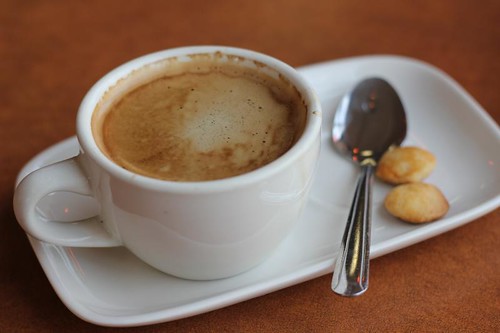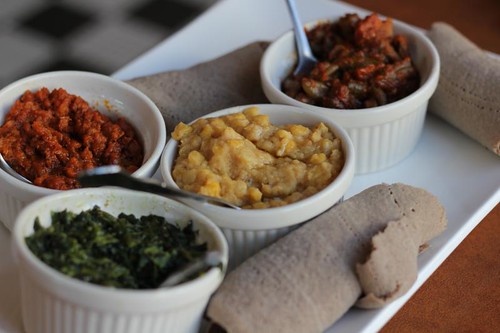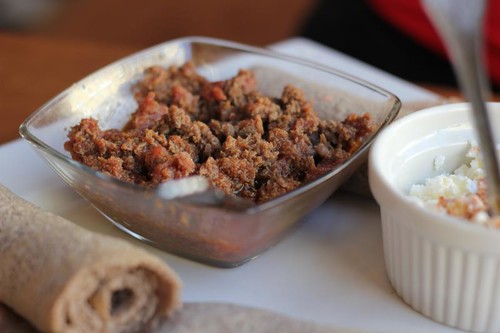
Two tales of trying to get a cup of coffee in this town:
Royal Coffee, 6764 N. Sheridan
I had never really paid attention to this place even though it’s just a couple of blocks from my kids’ school; the name “Royal” did little to suggest that it was, not a 50s coffeeshop when “Royal” was a common small business name, but an Ethiopian restaurant (and the royalty in question was the Emperor Haile Selassie, presumably). It is in fact the retail outpost of a coffee importer, and you get some advocacy for non-blended, single source Ethiopian coffee on the walls and menu, but more to the point, you get the coffee, which is really terrific and does taste like it came from one place without getting muddied up with other flavors.
Besides coffee, various food items are offered, paninis and muffins (probably from somewhere else) and so on, like at any coffeehouse. Up to this point, it’s a pleasant, clean and brightly lit coffeehouse, nice if you’re in the neighborhood.

But the interesting thing to look for on the menu is the page with the small selection of Ethiopian dishes. There’s not a lot, and I can’t swear that they make this stuff here (though it’s the kind of big-pot-of-stew stuff pretty much anyone could make). But what we had was pretty likable; Cathy Lambrecht and I ordered a vegetarian sampler for about ten bucks and got four bowls of different stews with injera (a spongy flatbread which you use to scoop the stews up). The red lentil one was my favorite, full of deep meaty flavor (though it’s meatless) and multileveled moderate heat; at the complete opposite end, the mild, comfy corn one was also good in a corn pudding-like way.

Cathy also wanted to order kitfo, the chopped beef tartare dish which is common throughout that part of the world. I wasn’t wild about a big plate of raw beef, but indulged her— and as it turned out, it wasn’t a big plate of raw beef, because it seemed to have sautéed before serving. The result, served with a white cheese, was a bit like eating the meat made with a packet of McCormack Taco Seasoning without the rest of the American taco, but it wasn’t bad.
African cuisine can be hard to get into— you have both food and dining rituals you are likely unfamiliar with— so I didn’t mind at all this light immersion into it in the setting of a bright, welcoming coffee house with a friendly, fairly attentive server. And the coffee’s very good; some time when I need to hang out by my kids’ school, I’ll be back, exploring Africa with laptop and coffee mug.
Brothers Coffee, 4720 N. Kedzie
I read some reviews of this place online— it sounded like a hopping coffee shop with an Arabic flavor. I formed a picture in my head of a place which combined Wicker Park barista skills with a middle-eastern souk feel, drawing a busy crowd of North Park University students perhaps; so one Sunday morning, I headed there with my son.
The reality proved to be an empty storefront consisting of a counter with the usual third world grocer offerings— phone cards and the like— which gradually became the proprietor’s living room as you moved toward the back. The bustling coffeeshop of my imagination was nowhere to be seen. Leaving his TV and cigarette the proprietor walked up to greet us, perhaps slightly mystified as to why we were there, but welcoming and friendly nonetheless.
There were the usual Bunn coffeemakers and warmers, but they were not in use that day, nor was the small espresso machine. I ordered a coffee, which he proceeded to draw from a countertop coin-operated machine which promised Jerusalem Coffee. The result was the most sugar-filled drink I have ever tasted. It was like drinking warm brown insulin. I know they like coffee and tea sweet in the middle-east, but do they really drink it this way in Jerusalem? Arthur C. Clarke once wrote a story about the discovery of life forms on the sun and the melancholy realization that there was life which we could never know, because it existed at temperatures that kept us at an unbreachable distance. That’s how I feel about the coffeehouse culture that can drink coffee this sweet— it will forever be a closed book to me.
I told the guy sorry, I just can’t hack this stuff, I’ll pay for it but maybe you could make, you know, a pot of American coffee in the American coffee pot? For some reason this was not possible because it would take 20 minutes. Instead he made me Turkish coffee. At least here I knew the drill— you have to wait for the grounds to settle into silt at the bottom if you don’t want a mouthful of grit. But was it to be that simple? Of course not. He had some kind of cardamom-flavored coffee— this was proudly shown to me, to let me know I was going to have something special— and where the coffee grounds would eventually sink, the tiny bits of cardamom would not. You couldn’t drink it without getting a mouthful of seeds and stems, basically.
When he wasn’t looking I poured most of it into the other cup, as if I’d drunk it and enjoyed it, and paid my bill. (My son had hot chocolate, uneventfully.) For $5 I’d had an education in the limits of cultural exchange, I guess, if not yet my morning coffee. But I remain baffled where the place I’d read about online was, and how others had found something to enjoy in a place that had completely defeated me.
Tags: brothers coffee shop, coffee, royal coffee

 Posted in
Posted in 




